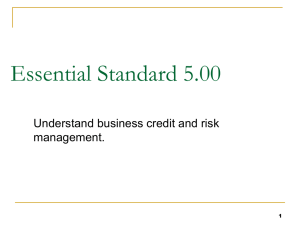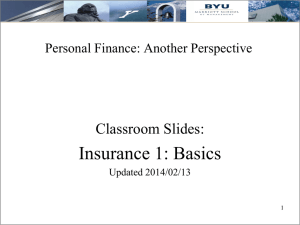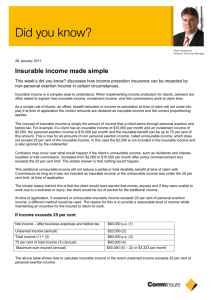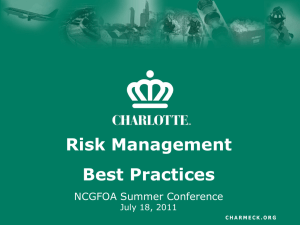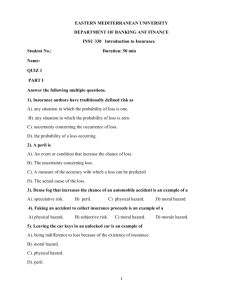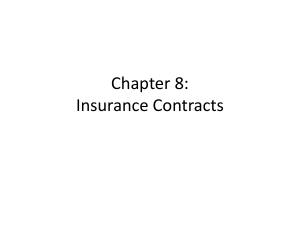Bonus Chapter B Study Guide
advertisement
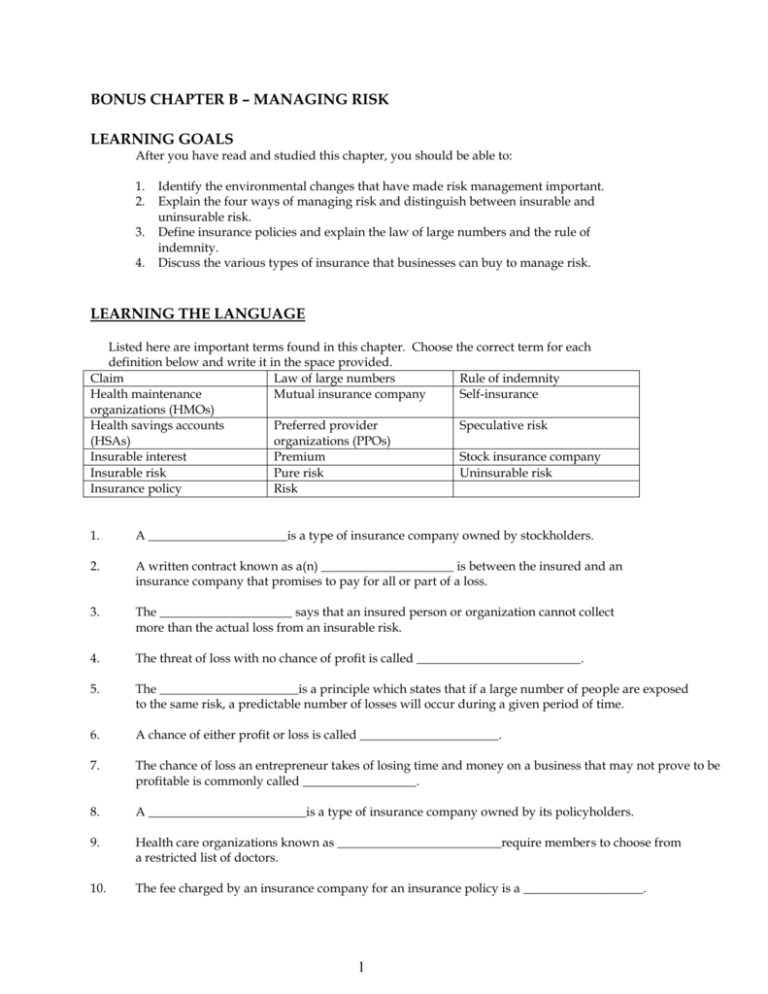
BONUS CHAPTER B – MANAGING RISK LEARNING GOALS After you have read and studied this chapter, you should be able to: 1. 2. 3. 4. Identify the environmental changes that have made risk management important. Explain the four ways of managing risk and distinguish between insurable and uninsurable risk. Define insurance policies and explain the law of large numbers and the rule of indemnity. Discuss the various types of insurance that businesses can buy to manage risk. LEARNING THE LANGUAGE Listed here are important terms found in this chapter. Choose the correct term for each definition below and write it in the space provided. Claim Law of large numbers Rule of indemnity Health maintenance Mutual insurance company Self-insurance organizations (HMOs) Health savings accounts Preferred provider Speculative risk (HSAs) organizations (PPOs) Insurable interest Premium Stock insurance company Insurable risk Pure risk Uninsurable risk Insurance policy Risk 1. A ______________________is a type of insurance company owned by stockholders. 2. A written contract known as a(n) _____________________ is between the insured and an insurance company that promises to pay for all or part of a loss. 3. The _____________________ says that an insured person or organization cannot collect more than the actual loss from an insurable risk. 4. The threat of loss with no chance of profit is called __________________________. 5. The ______________________is a principle which states that if a large number of people are exposed to the same risk, a predictable number of losses will occur during a given period of time. 6. A chance of either profit or loss is called ______________________. 7. The chance of loss an entrepreneur takes of losing time and money on a business that may not prove to be profitable is commonly called __________________. 8. A _________________________is a type of insurance company owned by its policyholders. 9. Health care organizations known as __________________________require members to choose from a restricted list of doctors. 10. The fee charged by an insurance company for an insurance policy is a ___________________. 1 11. A(n) _____________________is one that no insurance company will cover. 12. The practice of setting aside money to cover routine claims and buying only “catastrophe” policies to cover big losses is called ____________________. 13. A(n) ________________________is a risk that the typical insurance company will cover. 14. Health care organizations similar to HMOs except that they allow members to choose their own physicians for a fee are called _________________________. 15. The possibility of the policyholder to suffer a loss is called __________________________. 16. Tax-deferred accounts known as _________________ are linked to low-cost, high deductible health insurance policies. 17. The insured person sends a statement of loss called ____________ to the insurance company to request payment. ASSESSMENT CHECK Learning Goal 1 Understanding Business Risks 1. What is ERM? 2. What are the goals of ERM? a. ______________________________________________________ b. ______________________________________________________ c. ______________________________________________________ Learning Goa 2 Managing Risk 3. Describe the two kinds of risk. a. __________________________________________________________________________ ______________________________________________________________________________ b. ___________________________________________________________________________ ______________________________________________________________________________ 4. The kind of risk of most concern to business people is: ______________________________ 2 5. List four methods businesses use to manage pure risk. a. ________________________________ c. b. _______________________________ 6. _______________________________ d. _______________________________ What are of examples of how can a firm reduce risk? a. ___________________________________________________________________ b. ___________________________________________________________________ c. ___________________________________________________________________ 7. _________________________ to threats is critical to risk management 8. How do some companies avoid risk? 9. Self-insurance is most appropriate when: _________________________________________ 10. What does it mean for a company to “go bare” with self-insurance, and what is the risk? 11. What is a BOP? 12 Describe four kinds of uninsurable risk. a. __________________________________________________________________________ b. __________________________________________________________________________ c. __________________________________________________________________________ d. _________________________________________________________________________ 3 13. Identify the guidelines used to evaluate whether or not a risk is insurable. a. _________________________________________________________________________ b. _________________________________________________________________________ c. _________________________________________________________________________ d. _________________________________________________________________________ e. ________________________________________________________________________ f. ________________________________________________________________________ Learning Goal 3 Understanding Insurance Policies 14. What makes the acceptance of risk possible for insurance companies is: _____________ ___________________________________________________________________________ 15. How are appropriate premiums for each policy determined? 16. Today, many insurance companies are charging high premiums not for expected losses but for ____________________________________________________________________ 17. Can a person purchase more than one policy to cover the same risk? Explain. Learning Goal 4 Insurance Coverage for Various Kinds of Risk 18. 19. What are three types of insurance to cover losses? a. _____________________________________________ b. _____________________________________________ c. _____________________________________________ What are four major options for health insurance? a. ________________________________ c. b. ________________________________ d. ________________________________ 4 ________________________________ 20. What are the features of an HMO? 21. What are some complaints about HMOs? 22. What are some characteristics of a PPO? 23. Why do most businesses and individuals choose to join an HMO or a PPO? 24. Describe the features of a health savings account. 25. A major benefit to you of health saving accounts is__________________________________ ______________________________________________________________________________ 26. Describe disability insurance. 27. Who provides worker’s compensation and what does it guarantee? 28. Who does professional liability insurance cover? What is another name for this type of insurance? 29. What is product liability insurance? 30. To ensure those left behind will be able to continue the business, entrepreneurs often buy _______________________________________________________________________ 5 31. What should you do about insurance coverage if you have a home-based business? 32. What are the issues involved in risk management and the environment? CRITICAL THINKING EXERCISES Learning Goal 1 1. The “environment” changes so rapidly that it is difficult to identify all the changes that could affect a business in terms of risk management. Evaluate the company for which you work, or a company with which you are familiar. What is happening today in the environment (you remember this from chapter 1 - the economic and legal, technological, competitive, social, global business environments)? How do the changes you have identified increase the necessity for risk management for this firm? What actions can the firm take to minimize the risk of loss from these changes? Learning Goal 2 2. Businesses have four options to avoid losses stemming from pure risk situations. Reduce the risk Avoid the risk Buy insurance to cover the risk Self-insure against the risk Read the following situations, and determine which option the firm is choosing in each case. Use each option only once. a. ____________ The president of an asbestos removal firm in Merriam, Kansas closed his firm for four months. b. ____________ A group of 27 accounting firms formed its own insurance company to insure themselves. c. ____________ Workers and visitors on construction sites are required to wear hard hats. d. ____________ Senoret Chemical Company experienced a 1600% increase in its liability coverage premium. 6 3. Many variables determine which risks are insurable. Using your text, determine which of the following situations would constitute an insurable risk. a. ____________ TNG Enterprises would like to buy insurance to cover loss of computer equipment from power surges and possible spills. b. ____________ Gilmores, Inc. a retail store in Kalamazoo, wanted to insure against losses occurring when a competitor, Hudsons, implemented an aggressive marketing campaign. c. ____________ MEMC wants to buy insurance to cover losses created by a breakdown of their robotic and computer driven manufacturing systems. d. ____________ PPI, a small manufacturing firm, wants to insure themselves against losses created by damage from a fire set accidentally. e. ____________ Residents in Morgan City, Louisiana, East Lansing, Michigan and Valley Park, Missouri want to buy flood insurance. f. ____________ Residents of Morgan City, Louisiana, however, face a high risk of flooding, because the Mississippi River is cutting a new tributary through that city, and floods regularly. g. ____________ Boeing has extensive contracts with the government to build fighter planes. The company wants insurance to cover losses that may occur if Congress cuts the defense budget by over 20%. Learning Goal 3 4. Eric owns a company that makes self-darkening windshields for vehicles, Sun-2-Shade. He is aware of the risks of owning a business, and is considering various insurance plans. Eric would like to make sure that he won’t incur any losses, and so is thinking about buying policies from two different companies just to make sure that not only will he be covered, but could make money while the company was down. Eric figures that he will be able to make claims on both policies if something happens, and even make money when both companies pay on the claim. As Eric’s advisor, what would you tell him about this plan? 7 Learning Goal 4 5. You are a small business owner, currently working out of your home and you are concerned about the kinds of insurance that you should carry for your business. Currently, your business consists of yourself, and 3 employees. You have turned to a small business consultant to advise you. What do you think the consultant will say about the need for insurance? PRACTICE TEST MULTIPLE CHOICE – Circle the best answer Learning Goal 1 1. Risk management has become an important concern for businesses today because: a. insurance companies have done such a good job of marketing their products b. rapid environmental changes are becoming a major source of risk for companies.. c. companies want to insure themselves against potential losses. d. lawyers have made insurance claims a part of a company’s legal strategic plan. 2. An enterprise risk management program has as one of its goals: a. define which risks the program will manage. b. eliminate the risk of doing business. c. insure the company from environmental disasters. d. spread the risk of doing business over time. Learning Goal 2 3. When Macy’s orders inventory for the Christmas season, the company has to predict what their customers will want to buy that season. The kind of risk being described is a. speculative risk. b. pure risk. . c. insurable risk. d. self-insurance 4. It is when a company has several widely distributed facilities that ________________ is the most appropriate. a. reducing the risk b. avoiding the risk c. self-insurance d. finding another company to take the risk 8 5. An insurable risk is one in which: a. the loss is a specific amount. b. the loss is not accidental. c. the risk is dispersed. d. the policyholder has no insurable interest. Learning Goal 3 6. The law of large numbers states that: a. a large number of people must make claims before an insurance company will begin to pay out. b. if a large number of people are exposed to the same risk, a predictable number of losses will occur during a given period of time. c. items that will be covered by an insurance policy must not be above a certain amount, i.e. the large number which is set by actuaries. d. if losses from an occurrence are large enough, and insurance company will turn the policies over to a reinsurance company. 7. The idea that an insured person or organization cannot collect more than the actual loss from an insurable risk is called the: a. law of large numbers. b. rule of indemnity. c. disability insurance d. insurable interest. Learning Goal 4 8. A type of insurance that requires members to choose from a restricted list of doctors is called a: a. health maintenance organization. b. preferred provider organization. c. disability insurance. d. medical savings account. 9. Disability insurance a. replaces all your income if you become disabled. b. starts immediately after your disability. c. is required from employers. d. replaces a portion of your income. 10. If a person is injured when using a product and sues the manufacturer, the company is covered by a. workers compensation. b. disability insurance. c. product liability insurance. d. business interruption insurance. 9 11. Which of the following is true of worker’s compensation insurance? a. It guarantees payment of wages, medical care, and rehabilitation services for employees who are injured on the job. b. Only employers in right to work states are required to provide worker’s compensation insurance. c. The insurance does not provide benefits to the survivors of workers who die as a result of workrelated injuries. d. The cost of insurance is standard in any industry. 12. Business concern about damage to the environment: a. is primarily restricted to companies in the United States. b. is declining as companies add more insurance coverage as part of their strategic plans. c. has become a global issue because of concerns over issues such as climate changes. d. is primarily a concern of companies in the European Union and Eastern Europe. TRUE-FALSE Learning Goal 1 1. _____ An enterprise risk management system includes determining how risk management efforts will be coordinated across the firm. 2. _____ New legislation is being passed in some areas which aims to lessen some risk so companies can obtain insurance coverage at a reasonable price. Learning Goal 2 3. _____ A firm can reduce risk by establishing loss prevention programs such as fire drills, health education and accident prevention programs. 4. _____ Pure risk is the threat of loss with no chance for profit. 5. _____ When a company “goes bare” in terms of insurance, the company is getting the bare minimum insurance coverage from its insurance provider. One type of risk that cannot be covered is loss from accidental injury. 6. _____ Learning Goal 3 7. _____ The rule of indemnity states that you can have two insurance policies to cover the same risk of loss. 8. _____ A stock insurance company is one that insures the risk of being a stockholder. Learning Goal 4 9. _____ One of the complaints about an HMO is that members can’t choose their own doctors. 10. _____ Health savings accounts are tax-deferred accounts that allow you to save money for future medical expenses. 11. ____ Many professionals other than doctors and lawyers are buying malpractice insurance which is also known as professional liability insurance. 12. ____ Most homeowner’s insurance policies have adequate protection for a home based business. 10 13. ____ Workers’ compensation insurance guarantees payment of wages for employees injured on the job, but will not cover medical expenses, as those should be covered by medical insurance programs. 14. ____ Concerns about the environment stem from issues such as global warming and hazards from nuclear power plants. You Can Find It on the Net Visit the website http://www.rmmag.com/ which is the website for Risk Management magazine. What are the major concerns addressed in the current issue of the magazine? How do those concerns reflect what we have discussed in this chapter? What is the RIMS? Visit the home page of the insurance company you currently use for car, homeowners, or other insurance policies. What types of products does this company offer? Use this company’s website to determine if you have adequate insurance to cover your needs. Can this company insure your small business? What kinds of business insurance do they offer for your small business? 11 ANSWERS LEARNING THE LANGUAGE 1. Stock insurance company 2. Insurance policy 7. Risk 8. Mutual insurance company 3. Rule of indemnity 4. Pure risk 9. Health maintenance organizations (HMOs) 10. Premium 5. Law of large numbers 6. Speculative risk 11. Uninsurable risk 12. Self insurance 13. Insurable risk 14. Preferred Provider Organization (PPO) 15. Insurable interest 16. Medical savings accounts (MSAs) 17. Claim ASSESSMENT CHECK Learning Goal 1 Understanding Business Risks 1. ERM is an enterprise risk program, designed by executives for their companies. 2. The goals of an ERM can include: a. defining which risks the program will manage. b. what risk management processes, technologies, and investments will be required. c. how these efforts will be coordinated across the firm. Learning Goal 2 Managing Risk 3. a. Speculative risk involves a chance of either profit or loss. It includes the chance the firm takes to make extra money by buying new machinery, acquiring more inventory and making other decisions in which the probability of loss may be relatively low and the amount of loss is known. An entrepreneur takes speculative risk on the chance of making a profit. b. Pure risk is the threat of loss with no chance for profit. It involves the threat of fire, accident or loss. If such events occur, a company loses money, but if the events do not occur, the company gains nothing. 4. The kind of risk of most concern to business-people is pure risk. 5. Firms can manage risk by a. Reducing the risk b. Avoiding the risk c. Self-insure against the risk d. Buy insurance against the risk 6. Examples of reducing risk include: a. A firm can reduce risk by establishing loss-prevention programs such as fire drills, health education, safety inspections, equipment maintenance, and accident prevention programs. b. Retail stores use mirrors, video cameras, and other devices to prevent shoplifting. c. Manufacturers have safety devices to protect workers from injury. 12 7. Quick response is critical to risk management. 8. Companies avoid risk by not accepting hazardous jobs and by outsourcing shipping and other functions. For example, the threat of lawsuits has driven away some drug companies from manufacturing vaccines, and some consulting engineers refuse to work on hazardous sites. Some companies are losing outside members of their boards of directors for lack of liability coverage. Many companies have cut back on their investments to avoid the risk of financial losses. 9. Self insurance is most appropriate when a firm has several widely distributed facilities. 10. When a company “goes bare” the company is paying claims straight out of its budget. This is a very risky strategy for a company. The risk is that the whole firm could go bankrupt over one claim if the damages are high enough. 11. A BOP is a business ownership policy. This is a package that includes property and liability insurance, and reduces the cost of insurance. 12. Four kinds of uninsurable risk include: a. Market risks (from price changes, style changes, new products) b. Political risks (from war or government restrictions) c. Personal risks (from loss of job) d. Risks of operation (strikes or inefficient machinery) 13. An insurable risk is evaluated using the following criteria a. The policyholder must have an insurable interest. b. The loss must be measurable. c. The chance of loss should be measurable. d. The loss should be accidental. e. The risk should be dispersed. f. The insurance company can set standards for accepting risk. Learning Goal 3 Understanding Insurance Policies 14. What makes the acceptance of risk possible for insurance companies is the law of large numbers. 15. Appropriate premiums for insurance policies are determined by using the law of large numbers. Once the insurance company predicts the number of losses likely to occur, it can determine the appropriate premiums for each policy it issues against that loss. The premium is supposed to be high enough to cover expected losses and still earn a profit for the firm. 16. Today many insurance companies are charging higher premiums not for expected losses but for the costs they anticipate from the increasing number of court cases and high damage awards. 17. A person can’t buy two insurance policies and collect from both for the same loss. You cannot gain from risk management you can only minimize losses 13 Learning Goal 4 Insurance Coverage for Various Kinds of Risk 18. Three types of insurance include: a. property and liability b. health c. life insurance 19. Four major options for health insurance are: a. health care providers, such as Blue Cross/Blue Shield, b. health maintenance organizations (HMOs) c. preferred provider organizations (PPOs) d. medical savings accounts (MSAs) 20. HMOs offer a full range of health care benefits. Emphasis is on helping members stay healthy instead of on treating illnesses. Members do not receive bills and do not have to fill out claim forms for routine service. HMOs employ or contract with doctors, hospitals and other systems of health care and members must use those providers. HMOs are less expensive than comprehensive health insurance providers. 21. Members complain about not being able to choose doctors or to get the care they want or need. Some physicians complain that they lose some freedom to do what is needed to make people well and that they often receive less compensation than they feel is appropriate for the services they provide. 22. Preferred provider organizations contract with hospitals and doctors, but do not require members to choose only from those physicians. Members can use outside provides, for which they pay more. Members pay a deductible before the PPO will pay any bills. When the plan does pay, members usually have to pay part of the bill. This payment is called co-insurance. 23. Most individuals and businesses choose to join a PPO or an HMO because they can cost as much as 80 percent less than individual health insurance policies. 24. With a health savings account, you or your employer put part of the money currently spent on health insurance into a health savings account. You would use the money only for needed health care services. At the end of the year you get to keep the money you don’t spend in the account for future medical coverage. 25. One major benefit to you of a health saving account is that the money grows tax-free until you take it out. 26. Disability insurance replaces part of your income if you become disabled and unable to work. Usually, before you can begin collecting there is a period of time you must be disabled. The premiums for such insurance vary depending on your age, occupation, and income. 27. Workers compensation insurance guarantees payment of wages, medical care, and rehabilitation services for employees who are injured on the job. Employers in all states are required to provide this type of insurance. This insurance also provides benefits to the survivors of workers who die as a result of work-related injuries. The cost of the insurance varies by the category of business; higher risk jobs cost more to insure than lower risk types of jobs. 14 28. Professional liability insurance covers people who may be found liable for professional negligence, such as lawyers, doctors, dentists, mortgage brokers, and real estate appraisers. This is also known as malpractice insurance. 29. Product liability insurance provides coverage against liability arising out of products sold. 30. To ensure those left behind will be able to continue the business, entrepreneurs often buy life insurance that will pay partners and others what they need to keep the firm going. 31. Homeowner’s policies usually don’t have adequate protection for a home-based business, so you may need to add an endorsement, or rider, to increase the coverage. If clients visit your office and or if you receive deliveries regularly, you may need homeoffice insurance, which protects you from slip and fall lawsuits and other risks associated with visitors. More elaborate businesses may need other kinds of insurance. 32. Risk management goes beyond the protection of individuals and businesses from known risk. It now means evaluating the worldwide risks and prioritizing these risks so that international funds can be spent where they will do the most good. CRITICAL THINKING EXERCISES Learning Goal 1 1. Your answers to this question will vary. However, some suggestions as to how to minimize risk may include developing an enterprise risk management program for the company, to determine what risks pose the greatest danger to the company, and how to manage those risks. Learning Goal 2 2. a. Avoid risk b. Self-insure against the risk c. Reduce the risk d. Buy insurance to cover the risk. 3. a. b. c. Yes, companies can buy insurance against the loss of computer equipment. No, this would be an uninsurable risk. No, a company cannot insure against inefficient machinery or machinery that breaks down or doesn’t work. d. Yes you can insure against fire damage. e. Yes, probably, unless the occurrence of loss has been too high. 15 f. g. No, most likely because the probability of flooding in Morgan City is too high. No this would be a “political risk” and is uninsurable. Learning Goal 3 4. While it is understandable that Eric would be concerned about taking care of losses his business may experience, the rule of indemnity will prevent Eric from filing claims with two different insurance companies for the same incident. The rule of indemnity states that an insured person or organization can’t collect more than the actual loss from an insurable risk. If a company carries two policies, the two insurance companies would calculate any loss and divide the reimbursement. Leaning Goal 4 5. As a small business owner located in your home, you will need to have a regular homeowner’s policy, but there will be additional coverage that you should consider. You may need a rider to cover business equipment, and if customers or clients call on you, you may need home office insurance. If you manufacture items at your home business, you should consider a business owner policy. Depending upon the type of business you own, you may want to consider professional liability insurance or product liability insurance. Since you have employees, you may want to check into offering other insurance coverage for them. Employers often offer life insurance, disability insurance, retirement plans, and health insurance. You will probably be required to offer worker’s compensation insurance. The cost of worker’s compensation insurance will be determined by your company’s safety record, its payroll and the types of hazards faced by your workers. PRACTICE TEST MULTIPLE CHOICE 1. 2. 3. 4. 5. 6. a b a c c b 7. 8. 9. 10. 11. 12. TRUE-FALSE b a d c b c 1. 2. 3. 4. 5. 6. 7. T T T T F F F 16 8. 9. 10. 11. 12. 13. 14. F T T T F F T
